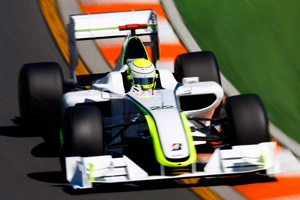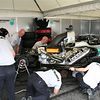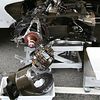Brawn BGP001 Mercedes

Active: 2009
Team: Brawn GP
Designer: Ross Brawn (TP), Nick Fry (CEO), Jorg Zander (DTD), Loïc Bigois (HA)
Drivers: Jenson Button (22), Rubens Barrichello (23)
Despite its very late arrival in the testing scene, the BGP001 immediately proved quick and reliable. In all the winter tests that Brawn GP came in action they dominated the field and showed strong and consistent pace both in short as well as in longer runs.
The new car was initially developed by Honda Racing F1 under the lead of Ross Brawn. Brawn signed up for the team after leaving Ferrari in the hope to get Honda back to the forefront, rather than running completely at the back. Hence development started early on and 2008 development was marginal compared to the 2009 effort.
When Honda then decided to leave F1, the car was mostly done but the team could keep on working on Honda's costs until Brawn eventually took over. By that time, a deal with Mercedes was done for the engines. A gearbox was also offered but the team decided to continue with its in-house carbon fibre cased solution.
As it appeared in testing, it immediately looked well developed and it quickly proved fast and reliable. After the first test, the team was delighted with the performance and the reliability of the track, probably helped by the fact that the team initially didn't plan a KERS system. While Honda had developed a flywheel solution in cooperation with Flybrid, Brawn GP does not have plans to run it in the BGP 001. The solution was however track-tested and is reported to be an all-mechanic solution fixed on the frontal side of the engine.
The first Brawn GP car features an interesting front wing with a decked element and a double endplate. The latter is a combination of 2 parallel panels to efficiently direct air away from the front wheels while also complying with the minimum surface regulations in this area. The wing is attached to a very low and wide nose cone that helps to keep the centre of gravity low - as ballast fitted in the nose will be lower to the ground.
To help airflow from the front wing and in between the front wheels, the steering arm of the front suspension has been positioned in line with the lower frontal wishbone. This particular design again adds for a lower centre of gravity as the steering components can all be lowered.
Ahead of the splitter is another interesting solution which was also tested by Williams. There, an upward curved panel is fixed to catch air and push it up, generating downforce in the process. Because of its similarities in function, this element is already called the 'snow plough'. All airflow under the horizontal splitter goes under the car and ends up creating downforce in the rear diffuser.
The sidepods on their behalf are tightly designed with small air inlets and a heavy undercut to reduce drag. No doubt the decision to not run KERS will have helped the engineers to push a little further as the car will have a lower need for cooling or electronic ancillaries.
Finally the car's rear end is marked by a more conventional rear wing. Low to the ground, the diffuser sports a closed and curved section in the middle, exploiting a loophole in the regulations which allows - or so was the intention - only straight, vertical elements to guide the airflow coming from under the car's floor.
Specifications
Chassis construction: Moulded carbon fibre and honeycomb composite structure
Suspension: Wishbone and pushrod activated torsion springs and rockers
Dampers: Sachs
Wheels: BBS forged magnesium
Tyres: Bridgestone Potenza
Brakes: Brembo calipers
Brake discs/pads: Carbon/Carbon
Steering: Power assisted rack and pinion
Steering wheel: Carbon fibre construction
Electronics: FIA standard ECU and FIA homologated electronic and electrical system
Transmission
Gearbox: Seven speed unit with carbon composite maincase
Gear selection: Sequential, semi-automatic, hydraulic activation
Clutch: Carbon plate
Dimensions
Overall length: 4700mm
Overall height: 950mm
Overall width: 1800mm
Engine
Type: Mercedes-Benz FO 108W
Capacity: 2.4 litres
Cylinder configuration: 90° V8
Maximum rpm: 18,000 (FIA regulatory limit for 2009)
Piston bore maximum:; 98mm (FIA regulation)
Number of valves: 32
Fuel: Mobil High Performance Unleaded (5.75% bio fuel)
Lubricants: Mobil 1 – for higher performance, lower friction and better wear resistance
Weight: 95kg (minimum FIA regulation weight)







